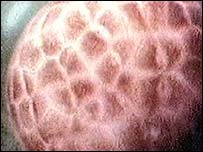

By Martin Hutchinson
Source: © 2003 BBC News Online
An experiment in the United States has created a mixed-sex human embryo.
The team involved insists that the creation of the embryo was designed to cure illness, but critics say moral and ethical standards have been breached.
The process they used creates what is known as a “chimaera” – a blend of two embryos, each of which would have a distinct genetic identities.
But any attempt to produce such a baby would provoke a worldwide ethical storm.

In experiments using donated embryos, scientists from the Centers for Human Reproduction in New York and Chicago investigated whether healthy cells from one embryo could be implanted into a second defective embryo.
They found that, in some cases, the introduced cells do proliferate and spread throughout the chimaeric embryo.
Their hope is that having even a small proportion of cells from a healthy embryo might prevent certain genetic diseases from arising.
The “merged” embryos were never intended to develop into children, and were destroyed after a few days.
However, other experts have dismissed the idea as “deeply flawed” – and say research into the issue, even in animals, should not continue.
Any use of chimaeric technology in human reproduction in the UK is illegal.
Dr. Norbert Gliecher, who led the research, told the European Society for Human Reproduction and Embryology annual meeting in Madrid: “It is not ready for clinical application in humans – I don’t want to suggest that.”
“But further exploration in animals is warranted – and who knows where this will take us?”
The potential for cells from two different embryos to fuse and become one “combination” individual is well known in nature – there have been examples where this has happened in early pregnancy in humans, with no apparent ill-effects on the resulting baby.
The theory behind Gliecher’s work is that some studies have suggested that in certain diseases caused by a single genetic defect, having even as few as 15% of the body’s cells free from the defect might be enough to stop the development of the disease.
He said his experiment showed that just a couple of cells injected into the embryo produced an embryo with, in many cases, an even distribution of cells carrying these new genes.
He deliberately injected a male cell into a female embryo – which created an “intersex” embryo, but allowed him to use chemical tests to check the process of the chromosome unique to male cells.
Gleicher said that a couple having embryos screened for a single-gene disease such as Severe Combined Immunodeficiency Disorder (SCID) might end up with two embryos, one of which had the disease and one which did not.
In this instance, he said, it might be possible to take cells from the “good” embryo and put them into the defective one, producing two viable embryos, whereas previously, the defective one would have to be discarded.
However, his experiment was roundly attacked by senior scientists at the conference.
Professor Alan Trounson, a pioneer of IVF in Australia, told BBC News Online: “I really can’t see the logic of what he is trying to do – it seems completely flawed to me.”
He said that it would be impossible to test whether the correct versions of the genes had been incorporated widely into the embryo before a decision had to be made whether to transfer it back into the woman.
He said that the health risks of producing a chimaeric individual were still uncertain.
“Unless you can be certain you are doing some good, you should not be doing something that could cause harm.”
He said that the US team should not even attempt to continue their experiments in animals.
Professor Lyn Fraser, a past president of the society, told the BBC that she shared the disquiet over the technique.
She said: “I don’t see how it can be used to treat single gene disorders. It’s hard to accept what they have done at all.”